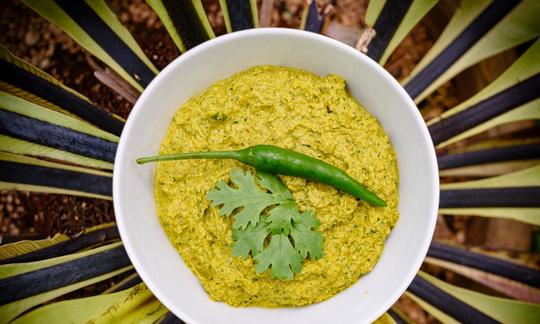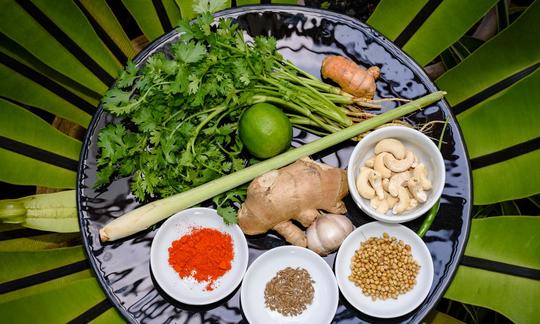Laksa curry paste with fresh turmeric and ginger
vegan
Ingredients (for servings, )
| 2 tbsp | Cashew nuts, raw? organic? (cashew nuts) (0.59 oz) |
| 3 cm | Turmeric, fresh (raw, organic?) (0.34 oz) |
| 3 cm | Ginger, raw (organic?) (1.1 oz) |
| 1 | Chili peppers, green (raw, organic?) (1.6 oz) |
| 1 stalk | Lemongrass, West Indian or Guatemalan lemongrass (0.88 oz) |
| 2 tsp | Real coriander, seeds (raw?, organic?) (0.13 oz) |
| ½ tsp | Cumin, seeds (raw, organic?) (0.04 oz) |
| ½ tsp | Cayenne pepper (raw?, organic?) (0.03 oz) |
| 3 cloves | Garlic (organic?) (0.32 oz) |
| ⅔ oz | Coriander leaves, raw |
| 1 tsp | Lime juice (raw?, organic?) (0.09 oz) |
Equipment
- skillet (frying pan)
- stove
- citrus juicer (lemon squeezer)
- shredder
Type of preparation
- chop or grind
- soak
- squeeze
- dry roast
- purée
- peel
Preparation
Preparing the ingredients
Soak cashews (or almonds) in warm water for 15 minutes.For a nut-free version, simply use pumpkin seeds instead of cashews.
Peel the turmeric and ginger and chop roughly. Remove the seeds from the chilli pepper if desired. First peel off the thick outer layers of the lemongrass and cut off the root end. Then finely chop the stem and use it.
Preparing the Laksa Curry Paste
Heat a small pan over a medium heat. Roast the coriander seeds and cumin seeds in the hot pan for 2-3 minutes until aromatic and then chop finely in a small blender.As an alternative to cumin seeds, you can also use fennel seeds.
Add turmeric, ginger, chili pepper, cayenne pepper, lemongrass, garlic, soaked and drained cashews, coriander and lime juice and puree until a smooth paste is formed.
If necessary, add about 1 tablespoon of water for 4 servings to help the ingredients combine better into a paste.
storage
The paste will last for 1 week in an airtight container in the refrigerator, or up to 2 months frozen.Serving size: One ingredient quantity for 4 servings yields approx. 100 grams of Laksa curry paste, enough for 4 portions of Laksa curry soup.
|
Nutritional Information per person
Convert per 100g
|
2000 kcal | |
|---|---|---|
| Energy | 50 kcal | 2.5% |
| Fat/Lipids | 2.2 g | 3.2% |
| Saturated Fats | 0.38 g | 1.9% |
| Carbohydrates (inc.dietary fiber) | 7.3 g | 2.7% |
| Sugars | 1.1 g | 1.2% |
| Fiber | 1.2 g | 4.8% |
| Protein/Albumin | 1.7 g | 3.4% |
| Cooking Salt (Na:6.4 mg) | 16 mg | 0.7% |
| Essential micronutrients with the highest proportions | per person | 2000 kcal | |
|---|---|---|---|
| Vit | Vitamin C (ascorbic acid) | 31 mg | 38.0% |
| Min | Manganese, Mn | 0.58 mg | 29.0% |
| Vit | Vitamin K | 19 µg | 25.0% |
| Min | Copper, Cu | 0.18 mg | 18.0% |
| Min | Iron, Fe | 1.5 mg | 11.0% |
| Elem | Potassium, K | 201 mg | 10.0% |
| Elem | Magnesium, Mg | 30 mg | 8.0% |
| Vit | Vitamin B6 (pyridoxine) | 0.11 mg | 8.0% |
| Elem | Phosphorus, P | 51 mg | 7.0% |
| Prot | Tryptophan (Trp, W) | 0.02 g | 7.0% |
Detailed Nutritional Information per Person for this Recipe
The majority of the nutritional information comes from the USDA (US Department of Agriculture). This means that the information for natural products is often incomplete or only given within broader categories, whereas in most cases products made from these have more complete information displayed.
If we take flaxseed, for example, the important essential amino acid ALA (omega-3) is only included in an overarching category whereas for flaxseed oil ALA is listed specifically. In time, we will be able to change this, but it will require a lot of work. An “i” appears behind ingredients that have been adjusted and an explanation appears when you hover over this symbol.
For Erb Muesli, the original calculations resulted in 48 % of the daily requirement of ALA — but with the correction, we see that the muesli actually covers >100 % of the necessary recommendation for the omega-3 fatty acid ALA. Our goal is to eventually be able to compare the nutritional value of our recipes with those that are used in conventional western lifestyles.
| Essential fatty acids | per person | 2000 kcal |
|---|---|---|
| Linoleic acid; LA; 18:2 omega-6 | 0.40 g | 4.0% |
| Alpha-Linolenic acid; ALA; 18:3 omega-3 | 0.01 g | 1.0% |
| Essential amino acids | per person | 2000 kcal |
|---|---|---|
| Tryptophan (Trp, W) | 0.02 g | 7.0% |
| Threonine (Thr, T) | 0.04 g | 5.0% |
| Isoleucine (Ile, I) | 0.05 g | 4.0% |
| Leucine (Leu, L) | 0.09 g | 4.0% |
| Phenylalanine (Phe, F) | 0.06 g | 4.0% |
| Valine (Val, V) | 0.07 g | 4.0% |
| Lysine (Lys, K) | 0.06 g | 3.0% |
| Methionine (Met, M) | 0.02 g | 2.0% |
| Vitamins | per person | 2000 kcal |
|---|---|---|
| Vitamin C (ascorbic acid) | 31 mg | 38.0% |
| Vitamin K | 19 µg | 25.0% |
| Vitamin B6 (pyridoxine) | 0.11 mg | 8.0% |
| Folate, as the active form of folic acid (née vitamin B9 and | 13 µg | 6.0% |
| Thiamine (vitamin B1) | 0.05 mg | 4.0% |
| Vitamin A, as RAE | 28 µg | 4.0% |
| Riboflavin (vitamin B2) | 0.04 mg | 3.0% |
| Niacin (née vitamin B3) | 0.41 mg | 3.0% |
| Vitamin E, as a-TEs | 0.34 mg | 3.0% |
| Pantothenic acid (vitamin B5) | 0.10 mg | 2.0% |
| Biotin (ex vitamin B7, H) | 0.51 µg | 1.0% |
| Essential macroelements (macronutrients) | per person | 2000 kcal |
|---|---|---|
| Potassium, K | 201 mg | 10.0% |
| Magnesium, Mg | 30 mg | 8.0% |
| Phosphorus, P | 51 mg | 7.0% |
| Calcium, Ca | 26 mg | 3.0% |
| Sodium, Na | 6.4 mg | 1.0% |
| Essential trace elements (micronutrients) | per person | 2000 kcal |
|---|---|---|
| Manganese, Mn | 0.58 mg | 29.0% |
| Copper, Cu | 0.18 mg | 18.0% |
| Iron, Fe | 1.5 mg | 11.0% |
| Zinc, Zn | 0.58 mg | 6.0% |
| Selenium, Se | 1.6 µg | 3.0% |
| Iod, I (Jod, J) | 0.79 µg | 1.0% |
| Fluorine, F | 1.1 µg | < 0.1% |
The Laksa curry paste with fresh turmeric and ginger is also suitable for dishes that require red curry paste.
Serving size: One ingredient for 4 servings yields approx. 100 grams of Laksa curry paste, enough for 4 portions of Laksa curry soup.
Laksa: Laksa is a Southeast Asian soup from Malaysia and Singapore. There are numerous variations such as Penang Laksa (Malaysian) or Katong Laksa (Singaporean), although the basic ingredients and pastes differ. This paste is used to prepare curry laksa.
Turmeric: Turmeric, also known as yellow ginger or turmeric root, comes from South Asia and belongs to the ginger family. Curcumin, one of the orange-yellow pigments in turmeric, has many beneficial effects on health, such as anti-cancer and anti-inflammatory properties and antioxidant potential. Fresh turmeric has a resinous, slightly burning taste; when dried, it tastes milder and slightly bitter.
Ginger: The ginger rhizome has an aromatic smell and a sharp, spicy taste, which is due to the substance gingerol, which is said to have anti-carcinogenic and anti-inflammatory effects. The substances borneol and cineole give ginger its digestive, antiemetic, appetite-stimulating and circulatory properties.
Cumin: Despite the similar name, cumin is not closely related to caraway and also differs greatly in taste. Ground cumin has a fresh and slightly spicy aroma, which it owes to the cuminaldehyde contained in the essential oil.
Lemongrass: Lemongrass, also known as "lemon grass", has a reed-like appearance and develops its lemony taste best when eaten fresh. Essential oils are responsible for the intense scent, which is why the lemongrass stalks are first pounded soft for many Asian dishes in order to improve the solubility of the oils.
Storage and processing: The paste will keep for up to 2 months when frozen, so it's easy to prepare in advance. Before processing, always sauté the paste in a little oil so that its flavors can fully develop. Then use as described in the Laksa Curry Soup recipe (page 128).
Turmeric can stain: If you use fresh turmeric, you should wear gloves when processing it, as turmeric stains extremely strongly. The root can also permanently stain light-colored kitchen utensils yellow.
Coriander: Opinions vary widely regarding the taste of coriander. Some people react to its intense, slightly soapy aroma with aversion or even nausea. According to statistics in Switzerland, 15% of all allergy sufferers are sensitive to coriander. There is no alternative with a similar taste. Flat-leaf parsley, although it looks similar, has a completely different taste.
Original Laksa: For an original Laksa, you use candelnuts, also known as light nuts or Indian walnuts, instead of cashews. The laksa leaves, which are responsible for the characteristic taste, have been replaced in this recipe with lots of coriander, which gives the laksa paste a greenish color. In the original, the paste is red due to dried shrimps and both fresh and dried red chili. In addition to the ingredients listed, galangal is also used.
Nut-free version: For a nut-free version, use pumpkin seeds instead of cashews.
Fresh turmeric or dried, ground turmeric: If you don't have fresh turmeric root, you can replace it with the ground version. For the corresponding replacement, add about 1 teaspoon of the ground form to about 20 grams of fresh turmeric. However, the dried form has a significantly different taste (see notes).





